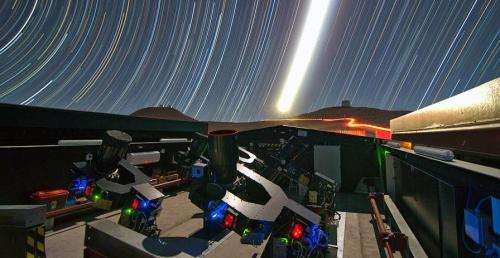Hunting transiting exoplanets

European Southern Observatory (ESO) gears up for the exoplanet hunting. The Next-Generation Transit Survey (NGTS), a wide-field observing system made up of an array of twelve telescopes was installed at ESO's Paranal Observatory in Chile. It will search for transiting exoplanets—planets that pass in front of their parent star and hence produce a slight dimming of the star's light that can be detected by sensitive instruments. "NGTS will have some sensitivity to habitable zone planets - these are planets at the right distance from their star that they would receive similar amounts of heat as the Earth does," Don Pollacco of the University of Warwick (UK) told astrowatch.net.
Pollacco helped build the NGTS. His research interests are primarily in the area of extra-solar planets. He was responsible for the SuperWASP instrument on La Palma which, along with its sister facility at SAAO, has become the most successful ground based planet detection experiment.
NGTS will focus on discovering Neptune-sized and smaller planets, hopefully habitable. The telescopes are designed to operate in a robotic mode and it will continuously monitor the brightness of hundreds of thousands of comparatively bright stars in the southern skies. It is searching for transiting exoplanets and will reach a level of accuracy in measuring the brightness of stars—one part in a thousand—that has never before been attained with a ground-based wide-field survey instrument.
NGTS also benefits from hardware and software heritage from the SuperWASP project, which since 2004 has been the world's leading in the discovery of transiting exoplanets of Jupiter size.
The discoveries of NGTS will be studied further using other larger telescopes, including the ESO Very Large Telescope. One goal is to find small planets that are bright enough for the planetary mass to be measured. This will allow planetary densities to be deduced, which in turn provides clues about the composition of the planets. It may also be possible to probe the atmospheres of the exoplanets whilst they are in transit. During the transit some of the star's light passes through the planet's atmosphere, if it has one, and leaves a tiny, but detectable, signature. So far only a few such very delicate observations have been made, but NGTS should provide many more potential targets.
"In the case of NGTS there will a mixture of relatively nearby stars and some slightly more distant, although not as distant as Kepler. The transit technique works when a planet moves across the face of its star," Pollacco said.
Pollacco is currently also the UK-spokesperson for the ESA CHEOPS mission - which will be concentrating on the transit characterization of small planets around bright stars found by radial velocity surveys, a science team member of the NASA FINESSE mission which aims to survey exoplanet atmospheres if selected starting in 2017 and the ESA PLATO mission for which he is the Science Coordinator. PLATO will do transit detection of rocky planets in the habitable zones of solar and nearby stars, allowing us to understand processes important in planet formation and evolution.
"ESA has recently selected the mission PLATO for launch in 2024 and this has the detection of habitable zone terrestrial planets around sun-like stars as one of its main science drivers," Pollacco said. "There are other missions that have attempted to do this but while they have candidates, they are so distant that confirmation or any other follow up observations are very difficult. The PLATO planets will be much closer."
Source: Astrowatch.net




















